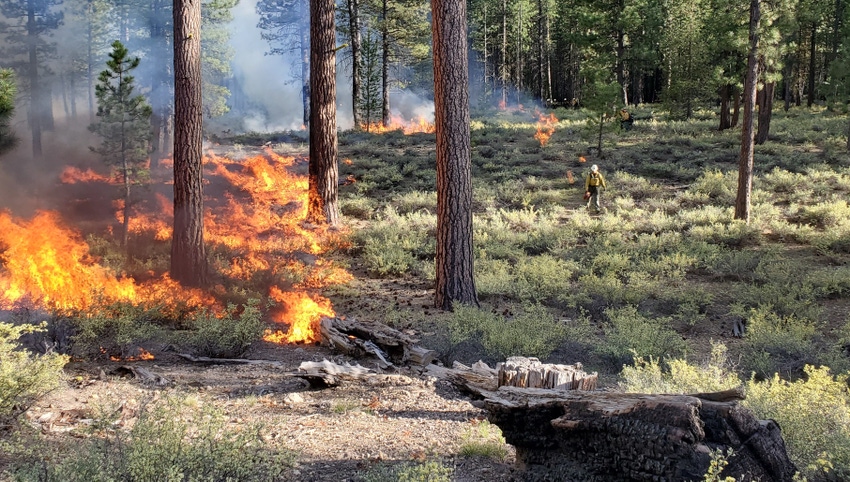May 31, 2022

Lessons from fires of the past can help the West's residents prepare for wildfires to come—and help our forests become more adapted to an era of fire.
Forestry scientists at Washington State University study wildfire and its impacts on the land, both bad and good. WSU Extension Foresters share current understanding about fire and how to reduce its ravages, helping rural landowners safeguard their homes, property, and natural resources.
“I want people to think about their forest,” said Sean Alexander, WSU Extension Forester for Northeastern Washington. “Have I protected the things that are most important to me? Does my forest have the best chance of surviving a fire?”
Statewide, last year saw the third worst fire season in burned acreage since 2014. In 2021, 674,000 Washington acres burned from fire, causing $372 million in damage.
While Alexander hesitates to predict what Mother Nature will do this year, “fire is never going to leave our landscape,” he says. “Lightning will strike, and there will always be people interacting with the outdoors. That will lead to fire starts.”
Burning to reduce fire danger
Fire has long been a keystone process for biodiversity in Western forests. Before the era of fire suppression, dry and lower-elevation Douglas-fir and ponderosa pine forests east of the Cascades burned every decade or two, in part due to the influence of Native Americans.
Prescribed fire, conducted under the right conditions, can reduce fuels, improve habitat, and safeguard timber and natural resources.
“The more we use fire as a land management tool, the less we need to be afraid of it,” says Mark Swanson, associate professor and faculty leader for WSU’s Forestry teaching and research program. “Native Americans were masters at using fire to reduce forest density and fuels. We profoundly need to learn from them.”
For nearly a decade, Swanson has been part of a multi-institutional team studying the effects of an unusual fire in California’s Yosemite National Park. In 2013, the Rim Fire burned more than a quarter-million acres on the west slope of California’s Sierra Nevada mountains, entering Yosemite, where managers had used prescribed fire for decades to reduce fuels.
Swanson and other scientists are closely studying a 60-acre plot, where firefighters ignited a prescribed, nighttime burn ahead of the main blaze to reduce fuels. Today, that forest more closely resembles its historic composition.
“As the understory opened up, we saw more deer and bird species,” Swanson said. “That system came alive when fire came back.”
Property owners could see similar effects with small, prescribed fires or ‘micro-burns,’ Swanson said.
Defense zones and adapted forests
Through dozens of annual workshops, such as the upcoming Forest and Range Owners Field Day, June 11 in Chewelah, Alexander and fellow Extension Foresters help Washington’s 218,000 forest-owning families understand the reality of wildfire.
“Proactivity happens in the fall, but last-minute defenses can be done now,” Alexander said. May is Wildfire Awareness Month, and a final opportunity to safeguard homes and private woodlands.
Alexander follows the National Fire Protection Association’s Firewise USA guidelines, instructing homeowners to defend the home ignition zones, a triple set of boundaries that include the first five feet out from your home’s exterior walls; the next 30 feet; and the extended landscape beyond.
Homeowners should strategically trim and prune to protect buildings, roads, driveways, and access routes, providing a way for fire crews to safely approach and fight a blaze. Landowners in dry, fire-frequent forests should thin and remove undergrowth and ‘ladder fuels’—branches and bushes that allow flames to climb into the canopy of trees, creating intense crown fires.
Thinning trees helps restore the natural structure and composition of the forest—the way it was decades or centuries ago, when local forests lived with fire.
“We’re not just separating fuels, we’re thinning down the dry forests to maximize resources for trees that remain, so they can grow big, develop thick insulating bark, and resist fire when it comes,” said Alexander, who stresses the need for forest owners to act cumulatively across communities to reduce severity. The biggest differences, he said, are made when people work together.
Next generation of woodland firefighters
Last year, Swanson launched WSU’s new Wildland Fire Ecology and Management course, which prepares young forestry professionals to become entry-level wildland firefighters. The first batch of 25 students awaits certification this spring.
Students learn standard tools, concepts, and practices, from understanding forest and weather conditions to digging a fire line and building an emergency fire shelter.
“We’re trying to prepare our students to be safer in a world that will be more dominated by fire,” Swanson said.
Find WSU Extension Forestry informational resources and courses at forestry.wsu.edu. Learn about the WSU Forestry academic program at WSU’s admissions website.
Source: Washington State University, which is solely responsible for the information provided and is wholly owned by the source. Informa Business Media and all its subsidiaries are not responsible for any of the content contained in this information asset.
You May Also Like




